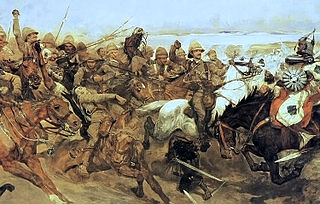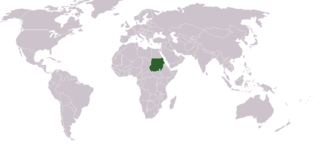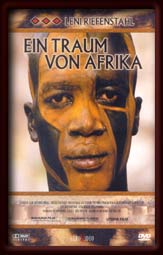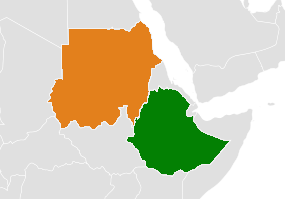
Khartoum or Khartum is the capital of Sudan. With a population of 5,274,321, its metropolitan area is the largest in Sudan. Khartoum is located at the confluence of the White Nile, flowing north from Lake Victoria, and the Blue Nile, flowing west from Lake Tana in Ethiopia. The location where the two Niles meet is known as al-Mogran or al-Muqran. From there, the Nile continues to flow north towards Egypt and the Mediterranean Sea.

Sudan, officially the Republic of the Sudan, is a country in Northeast Africa. It is bordered by Egypt to the north, Libya to the northwest, Chad to the west, the Central African Republic to the southwest, South Sudan to the south, Ethiopia to the southeast, Eritrea to the east, and the Red Sea to the northeast. Sudan has a population of 44.91 million people as of 2021 and occupies 1,886,068 square kilometres, making it Africa's third-largest country by area and also the third-largest by area in the Arab league. It was also the largest country by area in Africa and the Arab league by area before the secession of South Sudan in 2011, since which both titles have been held by Algeria.

The rich and varied music of Sudan has traditional, rural, East African roots, and also shows Arabic, Western or other African influences, especially on the popular urban music from the early 20th century onwards. Since the establishment of big cities like Khartoum as melting pots for people of diverse backgrounds, their cultural heritage and tastes have shaped numerous forms of modern popular music. In the globalized world of today, the creation and consumption of music through satellite TV or on the Internet is a driving force for cultural change in Sudan, popular with local audiences as well as with Sudanese living abroad.

Muhammad Ahmad bin Abd Allah was a Nubian Sufi religious leader of the Samaniyya order in Sudan who, as a youth, studied Sunni Islam. On 29 June 1881, he was proclaimed the first Mahdi of the three. He led a successful war against Ottoman-Egyptian military rule and achieved a remarkable victory over the British, in the Siege of Khartoum. He then created a vast Islamic state extending from the Red Sea to Central Africa and founded a movement that remained influential in Sudan a century later.

Wādī Ḥalfā is a city in the Northern state of Sudan on the shores of "Lake Nubia" near the border with Egypt. It is the terminus of a rail line from Khartoum and the point where goods are transferred from rail to ferries going down the lake. As of 2007, the city had a population of 15,725. The town is located amidst numerous ancient Nubian antiquities and was the focus of much archaeological work by teams seeking to save artifacts from the flooding caused by the completion of the Aswan Dam.

The Nuba people are various indigenous ethnic groups who inhabit the Nuba Mountains of South Kordofan state in Sudan, encompassing multiple distinct people that speak different languages which belong to at least two unrelated language families. Estimates of the Nuba population vary widely; the Sudanese government estimated that they numbered 1.07 million in 2003.
George Rodger was a British photojournalist noted for his work in Africa and for photographing the mass deaths at Bergen-Belsen concentration camp at the end of the Second World War.

Turkish Sudan, also known as Turkiyya, describes the rule of the Eyalet and later Khedivate of Egypt over what is now Sudan and South Sudan. It lasted from 1820, when Muhammad Ali Pasha started his conquest of Sudan, to the fall of Khartoum in 1885 to Muhammad Ahmad, the self-proclaimed Mahdi.

The Mahdist War was a war between the Mahdist Sudanese of the religious leader Muhammad Ahmad bin Abd Allah, who had proclaimed himself the "Mahdi" of Islam, and the forces of the Khedivate of Egypt, initially, and later the forces of Britain. Eighteen years of war resulted in the nominally joint-rule state of the Anglo-Egyptian Sudan (1899–1956), a de jure condominium of the British Empire and the Kingdom of Egypt in which Britain had de facto control over the Sudan. The Sudanese launched several unsuccessful invasions of their neighbours, expanding the scale of the conflict to include not only Britain and Egypt but the Italian Empire, the Congo Free State and the Ethiopian Empire.

The Central Bank of Sudan is the central bank of Sudan. The bank was formed in 1960, four years after Sudan's independence. It is located in the capital Khartoum.

The following outline is provided as an overview of and topical guide to Sudan:
Gadalla Gubara was a Sudanese cameraman, film producer, director and photographer. Over five decades, he produced more than 50 documentaries and three feature films. He was a pioneer of African cinema, having been co-founder of both the Pan-African Federation of Filmmakers FEPACI and the FESPACO Film festival. His daughter, Sara Gubara, who is a graduate of the Cinema Institute in Cairo, Egypt, assisted him with his later film projects, after he had lost his eyesight. She is considered to be Sudan's first female film director.

The Last of the Nuba is the English-language title of German film director Leni Riefenstahl's 1973 Die Nuba, a book of photographs, published a year later in the United States. It was an international bestseller and was followed up by the 1976 book Die Nuba von Kau. It was the subject of a famous critique by Susan Sontag in claiming that it adhered to a fascist aesthetic.

Leni Riefenstahl: Her Dream of Africa is a 2000 documentary-film by Ray Müller. The film follows Leni Riefenstahl's return to Sudan to visit the Nuba tribe whom she published photographs of in best-sellers such as The Last of the Nuba and The People of Kau. It is the second collaboration between Riefenstahl and Müller. She was the subject of his acclaimed 1993 documentary The Wonderful, Horrible Life of Leni Riefenstahl, which followed her life and reflected on her Nuba activities.

Ethiopia–Sudan relations date back to antiquity. One of Ethiopia’s principal trade routes ran west to Sudan and then to Egypt and the Mediterranean. Muslim merchants from Sudan have been an important part of Ethiopia’s trade for many centuries.
Cinema of Sudan refers to both the history and present of the making or screening of films in cinemas or film festivals, as well as to the persons involved in this form of audiovisual culture of the Sudan and its history from the late nineteenth century onwards. It began with cinematography during the British colonial presence in 1898 and developed along with advances in film technology during the twentieth century.

The Mahdi's tomb or qubba is located in Omdurman, Sudan. It was the burial place of Muhammad Ahmad, the leader of an Islamic revolt against the Ottoman-Egyptian occupation of Sudan in the late 19th century.
Ola Alsheikh, also known as Ola Abbas Alsheikh Omer, is a Sudanese freelance documentary photographer. She is mainly known for her pictures of everyday life and social events in Khartoum. In her work, she has placed a special focus on images of women and girls, as well as on the social and ethnic diversity in Sudan.

Francis Gregson was a British photographer and war correspondent, attached to the Anglo-Egyptian troops under the command of Herbert Kitchener during the reconquest of the Sudan. Gregson is believed to have been the author of an album of 232 photographs called "Khartoum 1898", taken during the Anglo-Egyptian military campaign in Sudan from 1896 – 98. These photographs in the archives of the National Army Museum, London, have been attributed to Gregson and constitute an important body of photographic records of this British military involvement in the Sudan. They have also been of importance in forming the public's views of 19th century British Imperial warfare.
Rashid Mahdi (1923–2008) was a Sudanese photographer, active in Khartoum from the 1950s to the 1970s. The French photographer and founder of a large archive of photographs dedicated to this 'Golden Age' of photography in Sudan, Claude Iverné called Mahdi "certainly the most sophisticated and one of the major African photographers of the XXth century."





























